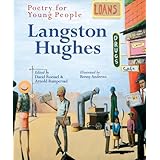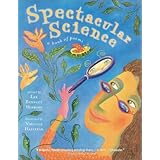
Bibliography-
Hughes, Langston. 2006. Poetry for Young People: Langston Hughes. Ed. by David Roessel & Arnold Rampersad. Ill. by Benny Andrews. New York: Sterling Publishing Co., Inc. ISBN – 978142718458.
Critical Review-
This collection of poems by Langston Hughes is part of a series of anthologies designed to bring the poetry of various artists to young people. The editors of this collection have perfectly captured the range of poetic genius that helps to define Langston Hughes. The anthology is a twenty-six poem collection with an in-depth introduction of the poet, Langston Hughes. Each poem has its own introduction which adds relevant information such as why he wrote the poem or its historical context. Below each poem, words that are critical to the meaning but may be unfamiliar to young people are defined. Likewise, the illustrations superbly complement each poem. The beauty and richness of African-American culture is wonderfully portrayed by this award winning artist. Careful attention is given to ensure that each poem selected has the necessary information to make it enjoyable and accessible to young people.
The care and quality in the construction of this anthology are only out done by the masterful poetry of Langston Hughes. The poems in this collection perfectly show the depth and breadth of his writings. In his poems, Hughes focuses heavily on African-American heritage and identity, along with American social and political injustices of his time, and other poems focus on the theme of dreams. It is not surprising that Lorraine Hansberry would select his poem “Harlem” to introduce her play A Raisin in the Sun which explores the dreams of ordinary African-Americans. Both Hansberry and Hughes wanted to capture the language and lives of ordinary people.
The selected poems show great diversity in mood ranging from humorous in “Final Curve” to total despair in “Genius Child.” Hughes uses the natural rhythm of language to create the cadences of his poems. He shows the interconnectedness of music and language by using natural dialect, rhyme, repetition, onomatopoeia, and alliteration. Also, Hughes expertly uses sensory imagery, similes, metaphors and extended metaphors to create poems that permanently penetrate the consciousness of the reader. The poem below is an example from this anthology.
Mother to Son
Well, son, I'll tell you:Life for me ain't been no crystal stair.
It's had tacks in it,
And splinters,
And boards torn up,
And places with no carpet on the floor-
Bare.
But all the time
I'se been a-climbin' on,
And reachin' landin's,
And turnin' corners,
And sometimes goin' in the dark
Where there ain't been no light.
So boy, don't you turn back.
Don't you set down on the steps
'Cause you finds it's kinder hard,
Don't you fall now-
For I'se still goin', honey,
I'se still climbin',
And life for me ain't been no crystal stair.
In the above poem, Hughes uses extended metaphor in having a mother give her son words of encouragement. She shares with her son that even though her life was difficult at times, she never gave up and he should not either. This is an example of the use of natural speaking dialect to develop the beat of the poem. The dialect is captured by dropping the final “g” in the suffix “ing”. Also, he uses dialect phrases such as “I’se” and “ain’t”. All of the dialect helps to establish the beat of the poem. Additionally, the use of repetition also contributes to the rhythmic quality of the poem.
Kid Connection-
This poem is a wonderful example to use when discussing extended metaphor. It could be used as a follow-up to the lesson. After the extended metaphor lesson, read the poem so the children can experience the richness of the dialect. Then point out to the students that the mother is comparing her life to a “crystal stair”. Discuss what they think a crystal stair might be. Next, have the students create poems to their mothers, grandmothers, or other role model in their life using Hughes’ technique of extended metaphor. Have students brainstorm possible comparison they could use for their lives. Encourage the students to use his format, but use their own dialect. This is an example of how it might start off for a boy this time of year:
Well, Mom, I’ll tell you:
Life for me isn’t a Super Bowl,
It’s had sacks in it,
And tackles….



